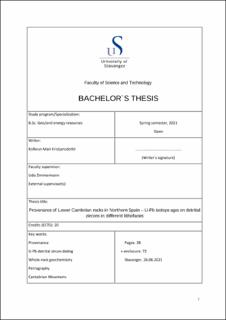| dc.description.abstract | The Herrería Formation with a Lower Cambrian depositional age exposed in the Cantabrian Mountains of northern Spain is the focus of this study. The motivation of this study is related to recognized significant provenance changes between the base of the formation and the top, which would have allowed fundamentally different provenance interpretations (Zimmermann, et al., 2015). Therefore, this study concentrates on a similar lithotype (quartz-arenites), which show a variety of differing sedimentary structures pointing to different sedimentary processes including sorting. The quartz-arenites are intercalated with shales devoid of carbonate material. The recognition of acritarchs pinpoints a marine depositional environment. The youngest detrital zircon age of the Herreria Formation is 524 ± 3Ma (Zimmermann, et al., 2015). Total of four samples were collected and to identify the differences and similarities of the provenance signals of these clastic sedimentary rocks, we apply optical petrography and whole-rock geochemistry, detrital zircon age. The results indicate that: All four lithotypes point to different possible maximum depositional age ranging from 549 Ma to 581 Ma with 32 Ma in difference and even more when comparing to the previous study (Zimmermann, et al., 2015). Although the rocks are supposed to be deposited in the same tectonic event, all samples fail to provide any younger depositional age than around 560 Ma. The detrital zircon population seem to differ between arenites and quartz-arenites where the latter see to reflect a more complete population. Therefore, studies with detrital zircon populations should be treated with great caution before being interpreted in stratigraphic context. Even with the large variety of different lithofacies sampled in this study it could not reflect the real Paleozoic depositional age, with an error of about 10 %. For the maximum depositional age determination, the base of the Herrería Formation would be the most ideal one studied, but not when trying to gain the entire provenance. I would argue for only using detrital zircon data with a detailed sedimentological background in addition to a known geological substructure. | |
